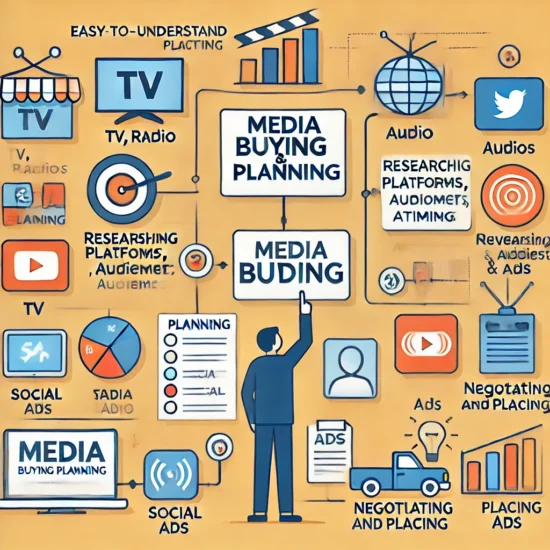What is Media Buying and Planning? – Media buying and planning are not just additional components, but the backbone of any successful advertising strategy in today’s fast-paced and increasingly digital marketing landscape. These two tactics work in tandem to ensure that a brand’s message reaches the right audience at the right time through the most effective channels.
But what exactly are media buying and planning, and why are they so crucial to marketing efforts? Media buying refers to purchasing advertising and marketing areas throughout various structures—whether it’s conventional media like TV, radio, and print, or virtual structures like social media, search engines like Google, and websites.
The intention of media buying is to steady favorable positions for advertisements on a satisfactory and feasible fee. It’s not just about locating the cheapest deal; it’s about making sure that the commercials are placed wherein they will have the greatest effect on the audience.
The achievement of media buying relies closely on negotiation competencies and a deep understanding of media platforms, target market behaviors, and advertising prices. Media planning, on the other hand, is the strategic phase that precedes the actual buying process.
It’s not just about research and identification of the best platforms, formats, and time frames for ads, but about creating a strategy that maximizes the brand’s visibility and engagement. Media planners, with their in-depth understanding of market trends, audience demographics, and past campaign performance, play a pivotal role in this phase, ensuring that the plan is executed efficiently and effectively.
Both media shopping for and making plans are critical for groups to navigate the crowded and aggressive advertising landscape. Without a nicely-notion-out media plan, even the pleasant classified ads can fall short.
Similarly, without a professional media purchaser, a tremendous plan might not materialize into meaningful consequences. In an era where consumers are bombarded with limitless commercials each day, strategic media shopping for and planning help brands stand out, attain the proper audiences, and attain their marketing objectives value-efficaciously.
Media Buying: The Basics
Building on the muse of media planning, media buying makes a specialty of the execution of a well-formed media method with the aid of shopping advertising space throughout selected structures. Media buying entails more than surely securing spots in magazines or airtime on TV.
With the upward thrust of digital advertising, it now encompasses everything from social media commercials to backed content, and Google seeks effects. At its core, media buying is about maximizing the go-back on marketing finances.
Media shoppers analyze wherein their target market spends time and negotiate with media shops to stabilize the quality placements for advertisements. These placements ought to align with the audience’s conduct, making sure the advertisements are visible at the right time and region.
Whether it’s a 30-second TV advert throughout prime time or a banner ad on a frequently visited website, the intention is to optimize attain and engagement. One key advantage of media buying is the potential to precisely goal a favored audience.
Buyers can tailor advertisements to unique demographic agencies primarily based on records and insights. However, a prime mission is a cost—particularly for premium slots, which can consume a considerable part of the advertising and marketing price range.
One of the challenges in media buying is the need for continuous performance monitoring. If ads are not performing as expected, media buyers must quickly adjust placements or renegotiate rates to avoid budget wastage. This dynamic nature makes media buying a careful balance between strategic investment and real-time adjustments to maximize the impact of a marketing campaign.

Media Planning: The Strategic Component
Effective media planning serves as the strategic foundation for successful media buying. It involves meticulous research and strategic planning to determine the most effective placement of ads to reach the target audience. While media buying is about execution, media planning is about vision and strategy.
The role of a media planner begins with a clear understanding of the campaign’s objectives. Whether it’s about increasing brand awareness, driving conversions, or targeting a specific demographic, the media plan must align with these goals.
Media planners analyze audience behaviors, trends, and platform performance to select the most suitable channels, all while considering budget constraints to ensure efficient use of every dollar across platforms like TV, social media, search engines, and traditional media.
Media planning goes beyond platform selection to focus on the timing of ad placements. A well-timed ad can make a significant difference, turning a potential overlook into a powerful impact. For instance, running an ad campaign during a major event that the audience follows can yield better results than at less strategic moments.
Effective media planning entails a deep understanding of the market, target audience insights, and media intake patterns. By tailoring the media strategy to unique behaviors and preferences, planners help make certain that the media shopping procedure offers its potential. Without a strong media plan, even the most skillfully sold ads threaten falling flat, making the making plans segment critical to a campaign’s basic success.
The Importance of Integration Between Media Buying and Planning
The integration of media buying and planning is vital for a cohesive and successful marketing marketing campaign. While media-making plans unite the strategic framework, media shopping brings that approach to lifestyles.
They ought to paint in concord to make certain that commercials aren’t only located within the proper spots but also are aligned with the broader advertising and marketing targets. With seamless integration, even the maximum nicely-researched media plans can succeed all through execution.
For instance, if a media customer does not steady the most reliable placements as laid out in the plan, the marketing campaign’s impact can be diluted. Similarly, suppose a media planner does now not remember the realities of price and availability throughout the planning phase. In that case, the media consumer can also struggle to locate powerful placements within the allotted finances.
Collaboration is prime. Media planners rely on customers to negotiate favorable deals and stabilize the nice viable positions for advertisements. In contrast, media customers expect planners to provide a clean, facts-driven method that informs their decisions.
This again-and-forth guarantees that the creative, imaginative, proactive, and practical factors of the campaign are aligned. As virtual advertising continues to conform with actual-time bidding and programmatic buying, the want for ongoing conversation among planners and shoppers becomes even extra vital.
Continuous tracking and adjustment of the campaign, based totally on overall performance facts, help keep the whole thing on target. When media buying and making plans are included well, campaigns run extra efficaciously, achieve higher returns, and ultimately meet their advertising and marketing desires greater efficaciously.

The Role of Data in Modern Media Buying and Planning
The role of facts in current media when shopping for and making plans is integral. With the upward thrust of digital systems and the supply of granular target audience insights, statistics has transformed how advertisers approach both making plans and buying degrees.
It’s no longer just about securing ad area; it’s approximately making knowledgeable, facts-driven decisions that maximize go back on investment (ROI) and enhance marketing campaign consequences. Data performs a key function in know-how target market behaviors and possibilities.
For media planners, statistics offers insights into where a target market spends their time, what content material they engage with, and how they reply to distinctive sorts of commercials. These statistics are critical for developing a media plan that speaks directly to the supposed audience.
Tools like Google Analytics, social media insights, and 1/3-birthday celebration facts systems allow planners to expect how a target audience will react to a particular advert and pick structures thus. For media consumers, actual-time records allow for brief adjustments and optimizations.
Programmatic advertising, as an example, uses records for goal-specific users based on their online conduct, bidding for ad placements in real time. This technique guarantees that advertisements are visible to the proper humans at the handiest moments, increasing the probability of conversion.
In precis, records bridge the distance between strategy and execution, making media shopping for and making plans a long way extra green and centered. It lets each planner and customer continuously refine campaigns for top-quality outcomes, making sure that every dollar spent contributes to the marketing campaign’s standard success.
The Future of Media Buying and Planning
The destiny of media buying and planning will evolve even further with advancements in technology and the unexpectedly changing digital landscape. One distinguished trend shaping the future is the growing use of synthetic intelligence (AI) and system getting to know.
These technologies are already making a large effect in programmatic marketing, taking into account more particular target markets focused on and actual-time bidding. As AI becomes greater sophisticated, we will expect it to automate a good deal of the decision-making technique in both making plans and shopping for, optimizing advert placements based totally on real-time performance facts and tendencies.
Another important issue is the developing emphasis on privacy. As purchaser records protection guidelines like GDPR and CCPA grow to be extra stringent, media planners and customers will want to discover new methods to goal audiences without infringing on privacy.
This may result in a shift from character-degree-focused to contextual marketing, wherein commercials are located based totally on the content material being eaten up as opposed to non-public data. Additionally, the upward thrust of omnichannel advertising and marketing is transforming how campaigns are planned and finished.
In the future, media techniques will increasingly need to account for the patron’s journey across a couple of touchpoints—social media, e-mail, websites, and even offline channels. This integrated method will require tighter coordination between media-making plans and shopping for groups to create cohesive, cross-platform reviews.
Ultimately, the destiny of media shopping for and planning can be pushed using technological innovation, records privacy concerns, and the want for an included, purchaser-centric technique to marketing. These elements will call for greater agility and collaboration from marketers than ever before.
Conclusion
In summary, media shopping for and making plans are vital components of a successful marketing strategy, making sure that manufacturers can efficiently reach their target audience with precision and effect.
Media planning provides the strategic foundation concerning in-depth research into target market behaviors, platform selection, and budget allocation; at the same time, media shopping brings this approach to existence through skillful negotiation and actual-time adjustments.
Collaboration among media planners and customers is vital for maximizing a campaign’s potential and attaining advertising objectives. As virtual advertising continues to adapt, information-driven insights have grown to be essential for optimizing each making plans and shopping for decisions, making an allowance for extra target audience focused and greater green use of budgets.
Looking ahead, improvements in AI, systems gaining knowledge of, and privacy guidelines will shape the future of media shopping and planning. Brands should adapt to those adjustments by leveraging new technology, ensuring compliance with records privacy laws, and turning in personalized, contextually relevant advertisements.
The destiny of media shopping for and planning will increasingly focus on creating incorporated omnichannel reviews that resonate with purchasers across multiple touchpoints, requiring more agility, collaboration, and innovation from marketers.
Frequently Asked Questions
What is media buying and making plans?
Media shopping for and making plans are interconnected procedures in advertising. Media-making plans include strategizing wherein, while, and the way to locate ads to attain a target audience effectively. Media shopping is the execution of that method, related to the negotiation and purchase of advert space across various platforms.
What is meant with the aid of media buying?
Media shopping refers to the manner of purchasing advert space on extraordinary systems, together with TV, radio, digital, or print, to vicinity advertisements where they will have the most impact on the audience. It entails negotiating fees and ensuring the foremost advert placements.
What do you suggest with the aid of media planning?
Media-making plans are a strategic technique that includes getting to know and identifying the fine platforms, codecs, and time frames for marketing campaigns. The goal is to ensure that the advertisements reach the right target market at the proper time to maximize engagement and ROI.
What do a media planner and consumer do?
A media planner creates a strategic blueprint for an advertising campaign, identifying the first-rate channels and codecs to use. In contrast, a media buyer executes that plan by negotiating and shopping the proper advert space to satisfy the campaign’s goals.
What is the position of a media buyer?
A media purchaser is accountable for buying ad areas throughout specific platforms, negotiating quality deals, and ensuring that the ads are placed in positions wherein they’ll be the handiest in reaching the target audience.
What is a media planner’s role?
A media planner’s position is to analyze and design a strategy for ad placement, analyzing market developments and audience behavior to determine the simplest platforms, timing, and formats to use for a marketing campaign, ensuring alignment with advertising and marketing dreams.
Read This: https://topalways.co.uk/how-we-see-each-other-trend-on-tiktok/


